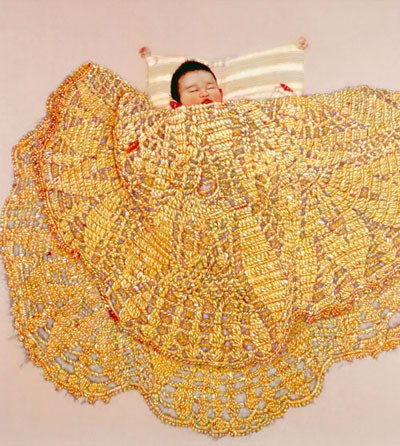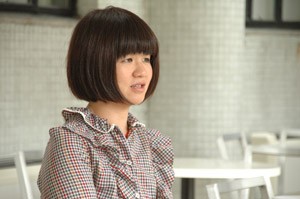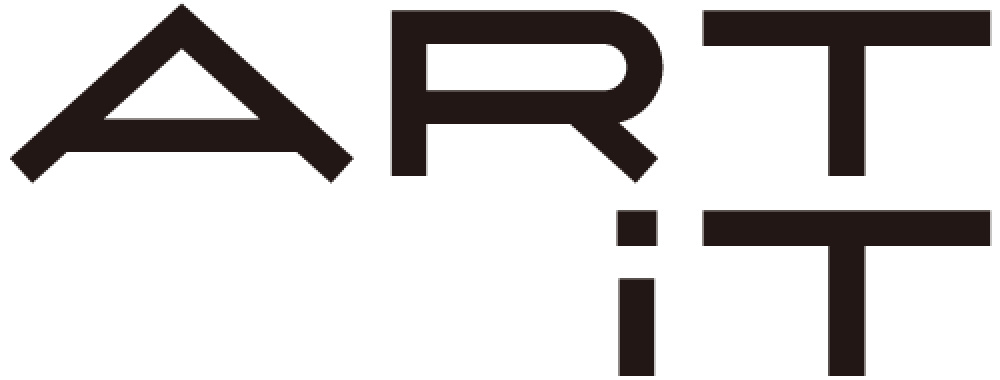Hara Documents 9 Masako Ando: The Garden of Belly Button has begun on July 12.
The curator in charge of the exhibition conducted an email-interview with the artist, which we present in three parts. Read on to learn about the background and ideas behind the work of this very gifted artist.

Light 2011 oil on canvas mounted on wood panel 111 x 100 cm ⓒMasako Ando Courtesy of Tomio Koyama Gallery
To form a landscape in her mind
Masami Tsubouchi (Curator of the exhibition, Hara Museum):
Since your first solo exhibition in 2004, we’ve been waiting for your new work. It is wonderful to be able to present them as part of the Hara Documents series at the Hara Museum. I hope you don’t mind me asking, but I wonder about the very slow pace at which you create your work. Is it because it takes time for a picture to germinate, like a seed? Or is it because of the way you make them?
Masako Ando:
I work as fast as I am able. I have never had any problem with seeds. On the contrary, there is always a plethora of them and the ground is thickly covered with growth.
The reason it takes so long lies in the process. To give visual form to things which exist only in my mind is quite a tough job. It was during my first solo exhibition that I felt I had finally grasped the tail of my own pictures, but was still groping along. Then I found a path from pencil drawing to painting, which was like first making sandals with the grass in the area, then asking for directions from the people that I met along the way.
It takes a long time especially for painting. Controlling the picture as I am adding colors to form the image is a process of trial and error. I naturally proceed with an aim in mind, but I have to adjust the entire image according to each modification that I make to a facial expression or color of a motif.
So the work is a constant alternation between details and overall image. Each time I harmonize the image with a brush or finger, about half of the image disappears. It repeats like this for each step: paint a little, harmonize the rest, paint a little, harmonize the rest. This was the routine I used for the leaves of the Morning Glory and the peacock feathers. It makes me tired just thinking about it again (laughs). I’ve been working while raising a baby now for three and a half years, and so I must be working faster than I was before.
As for pencil drawings, you might compare that pace to going somewhere on a bicycle, while paintings is like walking in sneakers.
Hearing the voice of the picture
Tsubouchi:
I now see how making progress involves an incredible amount of trial and error. I felt overwhelmed just by listening to you But in concrete terms, how do you produce that special porcelain quality in the surface of your works?

Like a Fiend Hid in a Cloud 2006 oil on canvas mounted on wood panel 190 x 140 cm each (diptych)
ⓒMasako Ando Courtesy of Tomio Koyama Gallery
Ando:
First, I stretch the canvas onto a panel. Then I brush gray onto foundation white as a base.
I apply this in layers, which I dry one at a time until every pore over the entire surface of the canvas is sealed and invisible to the eye. After the surface has dried completely, I polish it, trace the pencil drawing onto the canvas and gradually apply color. As I paint, I listen to the voice of the painting. I hear a voice telling me to “Paint here!” or “Do this part next!” As the voice is quite adamant, I reply “Yes! I’ll do it!” When I am working, I’m a servant to the picture. It is this process that produces the surface that you mentioned.
Specifically, there are two types of oil colors: transparent and opaque. I cannot create my pictures with only one or the other.
Putting it more precisely, with each addition, such as a human face or leaves, the picture becomes more rigid and the different elements separate from each other. Because I want the details to return to the whole, I glaze the entire image with transparent color. A glaze is made by dissolving color in linseed oil and applying it in very thin layers with a brush or the palm of the hand. It’s like covering the canvas with light-colored cellophane.
When the whole image is unified, one can go forward. If the transparent color becomes too noticeable, the image becomes indecisive and lacks resistance, so I add opaque pigment of almost the same color as the transparent one. If the surface feels rough, I polish it with sandpaper. If I want to add texture, I glaze or add details in only a part of the canvas. I do all this intuitively, in every part of the picture. This intuition of mine is like an eel with a slippery tail that I do my best to hold on to as I run along.
In the end, I achieve the texture that I want, the picture becomes mine for better or for worse, and the canvas that was once loud slowly quiets down and says “I think that’s enough.”

Portrait of the artist
(to be continued)
————————————————-
Hara Museum of Contemporary Art
Hara Documents 9: Masako Ando – The Garden of Belly Button
July 12 (Thursday) – August 19 (Sunday), 2012
